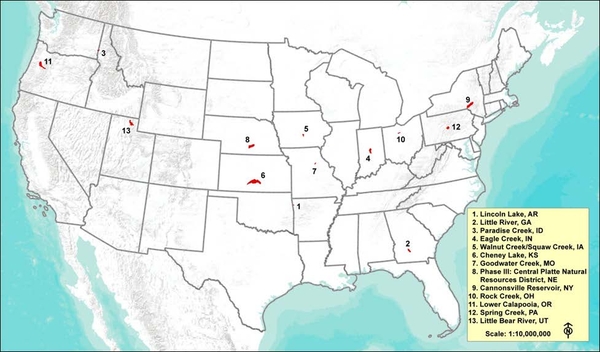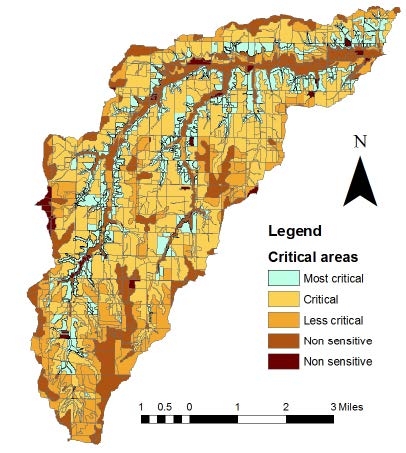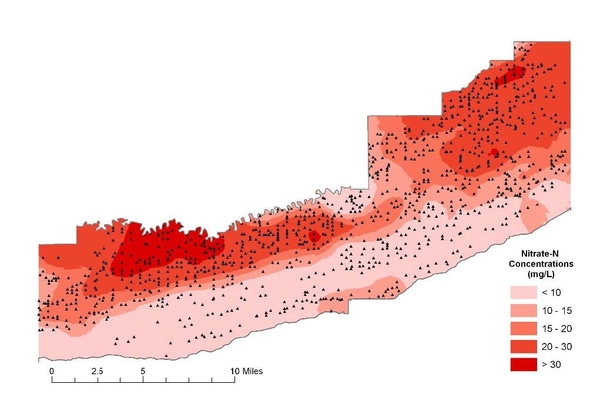NIFA Conservation Effects Assessment Project (CEAP)
Watershed Assessment Studies
Lessons Learned from the National Institute of Food and Agriculture (NIFA)-CEAP Synthesis Fact Sheet 6
Thirteen agricultural watershed projects were funded jointly by the USDA National Institute of Food and Agriculture (NIFA) and Natural Resources Conservation Service (NRCS) to evaluate the effects of cropland and pastureland conservation practices on spatial and temporal trends in water quality at the watershed scale. In some projects, participants also investigated how social and economic factors influence implementation and maintenance of practices. The 13 projects were conducted from 2004 to 2011 as part of the overall Conservation Effects Assessment Project (CEAP). The NIFA-CEAP projects were mainly retrospective; most conservation practices and water quality monitoring were implemented through programs that occurred before the NIFA-CEAP projects began. By synthesizing the results of all these NIFA-CEAP projects, we explore lessons learned about selecting and applying simulation models as evaluation and planning tools for watershed conservation projects and the relationship between monitoring data and modeling in conservation practice evaluation.
Simulation modeling is a powerful scientific tool that allows us to ask questions, assess alternatives, and support decision making for environmental management. Appraising the individual and cumulative effects of conservation practices on water quality using monitoring data can be costly and, in some cases, impractical, especially for retrospective studies. Watershed models can facilitate dynamic hydrologic and water quality assessments under scenarios that cannot be investigated practically using actual watershed experiments. For these reasons, watershed modeling was the primary approach encouraged in the NIFA-CEAP projects to evaluate existing and potential conservation practices; examine the role of location, timing, and interactions between practices on water quality; and identify optimal sets of conservation practices to meet water quality priorities.
Most of the NIFA-CEAP projects used watershed modeling to predict pollutant loads under historic land use, climatic, and conservation conditions at different spatial and temporal scales; to estimate the effects of existing and potential land treatment on pollutant loads at the watershed scale; or to determine the optimal suite of practices for achieving water quality goals at the lowest cost. Some of the projects used models to explore geospatial and temporal factors that determine the effectiveness of conservation practices and to understand trade-offs between water quality and socioeconomic constraints for implementing practices at the watershed scale. A few of the NIFA-CEAP projects used models to build knowledge about a watershed system, including learning about critical hydrological processes that control the variability of runoff and pollutant source areas and developing standard procedures for numerically representing conservation practices. The Soil and Water Assessment Tool (SWAT) was the most commonly used model among the projects; Annualized AGricultural Non-Point Source (AnnAGNPS), Water Erosion Prediction Project (WEPP), and GWLF models were also used. In several projects, researchers made important modifications to model algorithms to enhance a model’s performance according to their particular watershed characteristics.
Applying Models to Evaluation of Conservation Practices in Watershed Projects
Watershed models span a continuum of complexity with respect to data requirements and modeling structure, both of which influence the quality of modeling results and especially uncertainty. Considerable expertise was required to properly apply watershed models in the NIFA-CEAP projects. Accurate modeling required comprehensive knowledge of hydrologic and biogeochemical processes and essential characteristics of the watershed system under study, plus skills in computer programming, GIS, and statistical data analysis. The absence of such expertise can, at best, result in model applications that lack reasonable credibility or, at worst, derail a project entirely until the expertise is acquired. For example, a misunderstanding of a selected model’s data needs and its capacity to represent the watershed system in one of the projects resulted in canceling the entire modeling effort from the project.
Lesson: Agencies that choose to use complex watershed models must ensure that their personnel are trained for the development, calibration, and credible application of watershed models and that the selected model is appropriate for their application. Without these assurances, there is a high likelihood that modeling results will be incorrect and that the inferences will be misleading.
Modeling efforts in the NIFACEAP projects revealed that commonly used models lack adequate representation of some watershed processes. In one project, for example, field observations identified gully erosion from agricultural fields as a primary mechanism for transport of sediments and P to a lake. SWAT was used to simulate hydrologic and water quality fluxes in the system. But because SWAT cannot simulate ephemeral gully erosion, the model calibration had to overestimate upland sheet and rill erosion to predict measured sediment loads. This effect could skew the estimated benefits of conservation practices such as conservation tillage and terraces. In another case, the simplified algorithms used by SWAT to represent subsurface movement of water and chemicals meant that the model could not reasonably predict the effects of conservation practices on constituents such as nitrate-N that are transported primarily via groundwater pathways. Finally, another project had to deal with the impact of extensive subsurface drainage.
Lesson: The complexity and nonlinear nature of watershed processes overwhelm the capacity of existing modeling tools to reveal the water quality impacts of conservation practices. Improvements are needed in model representation of interactions between upland pollutant loadings and within-channel sediment and nutrient processes, overland routing, and subsurface processes.
In several of the NIFA-CEAP projects, participants found it difficult to represent conservation practices in model code. For example, the USLE practice factor was used as a surrogate to represent grassed waterways in one project, although established practice factor values are not available for grassed waterways. Therefore, this procedure is not widely accepted and could be a source of considerable error. In another project, other atypical ways of representing grassed waterways and residue management were used. In general, consistency was lacking among all projects, and therefore, comparing the estimated benefits of the same practice from different projects was challenging. Finally, none of the existing models can account for operation and maintenance of conservation practices or degradation of practice benefits over time.
Lesson: Incorporation of better procedures for representing conservation practices and their performance over time must be a priority in developing the next generation of watershed models. The availability of consistent practice representation can minimize the subjectivity of watershed modeling and improve the comparability of estimated environmental benefits among projects.
In many NIFA-CEAP watersheds, lack of access to spatially specific land treatment and agricultural management information essentially prevented modeling of the spatial and temporal effects of practices. Information about the amount and timing of nutrient and pesticide applications was also vital, but largely unavailable, for evaluating the performance of land treatment options at the watershed scale.
Lesson: Access to information about the location, time of implementation, operation, and maintenance of conservation practices is essential for evaluating their effects, particularly when the goal is to understand the role of location, timing, and a suite of practices on water quality.
Several of the NIFA-CEAP projects were conducted in areas of changing land use. One project documented that increased sediment and nutrient loads in some tributaries could be mainly attributed to urban development. Rapid urbanization during the project assessment period was also documented in another project. In a third project, modeling results indicated that land use change from pasture to forest reduced total P yield to a reservoir by 20% over the 1992—2005 period, while land use change and conservation practices in combination reduced total P yield to the reservoir by 45%.
Lesson: Models used for conservation assessment and planning must include the capacity to represent temporal changes in land use, particularly in watersheds where land use evolves over the course of the assessment period. Effects of changes in land use on fluxes of water and pollutants must be considered when evaluating the performance of land treatment options.
Some NIFA-CEAP projects developed sophisticated economic models, including Pareto efficiency frontiers, genetic algorithms, and mixed integer programming, to review environmental and economic trade-offs among numerous combinations of possible land uses, physiographic conditions, and conservation practices. In general, however, economic models were not fully integrated or applied in most of the projects. Timing was an issue in one project where the economic analysis was conducted early in the project and did not benefit from the water quality simulations that were conducted later in the project. Researchers could estimate costs and returns of individual conservation practices, but were not able to make a strong case for expanding the practices to many farmers. In addition, while the flexibility of seeing tradeoffs was desirable, models did not generate a concrete conclusion. None of the studies went the next step to show how farmers and other stakeholders could or would work to agree on the appropriate level of trade-off. Almost no economic information was extended to farmers. Finally, the data problems for the economic modeling were an issue with some of the same problems as fate and transport modeling. For example, not enough was known about the specifics of conservation practices, resulting in budgets that represent likely cost and returns.
Lesson: To take full advantage of the power of modeling analysis, economic modeling must be linked to other modeling efforts, such as land treatment, water quality monitoring, and watershed modeling that permit and encourage feedback among these components.
Improving the Use of Simulation Modeling in Watershed Conservation Planning and Assessment
The experiences with simulation modeling in the NIFACEAP projects point to the following lessons learned and opportunities to improve the use of modeling for watershed projects:
- In some projects, modeling proceeded based on what could be done, rather than what should be done. To be effective, the model, the supporting data, and the user’s skill must match the problem to be addressed.
- Model developers and researchers must continue to press the development of sound and credible algorithms for watershed modeling of conservation practices. Model developers must insist upon and facilitate the consistent and proper use of models by offering continued support for selecting and applying watershed models.
- Model developers and funding agencies should adopt and promote a set of standard procedures for model application to establish credibility for model application in watershed projects. These standards should include setting objectives and hypotheses for modeling, selecting an appropriate model, procedures for collecting watershed data of acceptable quality, sensitivity analysis, uncertainty analysis, calibration and validation procedures, interpreting model outcomes, and documenting the modeling process.
- Organizations that support model development and application should require a Quality Assurance Project Plan for model application when disseminating requests for proposals and require peer review of that plan before approving the project.
- The use of models for collaborative learning purposes should be encouraged; stakeholders should be included in the model building and application process.
Integrating Modeling and Monitoring in Watershed Projects
Modeling and monitoring were both key elements in the NIFA-CEAP projects. Monitoring provides essential data about the resource, but it can be expensive and challenging and requires careful design and execution to achieve objectives (see “Water Quality Monitoring for the Assessment of Watershed Projects,” CEAP Synthesis Fact Sheet 5). Modeling is indispensable in evaluating alternative scenarios and in forecasting water quality over time. However, the following must be recognized: Effective modeling requires actual water quality data for calibration and validation. Applying a model without observed data can contribute to skepticism and uncertainty about model results that can compromise the utility of modeling for watershed management.
Clearly, monitoring and modeling are not mutually exclusive. Each tool has its own strengths and weaknesses and neither can by itself provide all the information needed for water quality decision making or program accountability. Monitoring data can provide real evidence of water quality impairment and represent the best evidence of water quality restoration. Modeling can extend and apply the knowledge gained and can forecast future responses to alternatives. Monitoring can provide fundamental knowledge about the generation, fate, and transport of nonpoint source pollutants. Modeling provides the means to assemble, express, and test the current state of that knowledge and point the way for future investigations.
Some NIFA-CEAP projects were successful in combining monitoring data with modeling to address project objectives in ways that neither tool could achieve alone. However, monitoring and modeling can be better integrated in future watershed projects. Future programs should employ the strengths of both tools.
Lessons:
-
Use the strengths of both tools.
- Simulations and extrapolations must not entirely replace on-the-ground monitoring.
- Modeling can provide guidance on where and how on-the-ground monitoring is best conducted.
- Data collected through monitoring are essential for calibrating and validating models, and for establishing credibility for modeling- derived information.
- The validity of model application and the types of questions that are addressed must be corroborated by watershed stakeholders.
- Start from objectives, not a budget bottom line.
- Models selected by cost or convenience before setting objectives are unlikely to meet needs—select a model suitable for the project.
- A monitoring program based solely on budget may collect too few samples, too infrequently, yielding data that cannot serve project objectives.
- Begin with project objectives and design the program to do what can be done well to meet those objectives.
- Pay attention to source data.
- Availability of data at consistent scales and of known quality is essential to an integrated monitoring- modeling effort.
- Spatially and temporally explicit land treatment and agricultural management data are necessary for both water quality monitoring and watershed modeling.
- Evaluate the suitability of both existing monitoring data and programs and proposed model(s) for the project.
- Evaluate existing monitoring data for quality, consistency, and suitability for project purposes.
- Evaluate candidate watershed models for applicability to watershed characteristics, user technical competence, and the resources necessary to apply and support modeling in the project.
- Verify that important watershed characteristics (e.g., claypan soils) and conservation practice functions can be adequately represented in the selected model(s).
- Funding agencies should insist that these issues of data and model suitability be addressed in the project planning and proposal review stages, not after a project is funded and underway.
- Coordinate water quality monitoring and watershed modeling activities in a project so that information from each effort can be collected, shared, and combined at appropriate times to meet project goals.
Related Resources
Exner, M. E., H. Perea-Estrada, M. L. Liedtke and R. F. Spalding. 2009. Evaluation of the effectiveness of selected farm practices in reducing groundwater nitrate concentrations. Proceedings of the 2009 USDA-CSREES National Water Conference, February 8-12, 2009, St. Louis, MO.
Nelson, N., D. Devlin, K. Douglas- Mankin, and P. Barnes. 2011. Cheney Lake Watershed: Modeling the Effect of No-till. Kansas State University Agricultural Experiment Station and Cooperative Extension Service, Publication MF3036. Manhattan, KS.
Osmond, D., D. Meals, D. Hoag, and M. Arabi (eds). 2012. How to Build Better Agricultural Conservation Programs to Protect Water Quality: The National Institute of Food and Agriculture Conservation Effects Assessment Project Experience. Ankeny, IA: Soil and Water Conservation Society.
Information
For more information about the NIFA-CEAP Synthesis, contact Deanna Osmond, NC State University.
Lessons Learned from the NIFA-CEAP
Acknowledgments
The authors are grateful for the funding supplied by the USDA National Institute of Food and Agriculture (NIFA) and Natural Resources Conservation Service (NRCS) (Agreement No. 2007- 51130-18575). We want to thank all NIFA-CEAP project personnel for their help with this publication, our site visits, and our information-gathering efforts. In addition, we greatly appreciate all the time spent by key informants during our interviews with them. We also wish to thank the USDA CEAP Steering Committee and USDA NIFA Committee for Shared Leadership for Water Quality for their comments, questions, and advice during this synthesis project, as well as a special thanks to Lisa Duriancik of NRCS.
This material is based upon work supported in part by the National Institute of Food and Agriculture and the Natural Resources Conservation Service, U.S. Department of Agriculture, under Agreement No. 2007-51130- 18575. Any opinions, findings, conclusions, or recommendations expressed in this publication are those of the author(s) and do not necessarily reflect the view of the U.S. Department of Agriculture. USDA is an equal opportunity provider and employer.
Prepared by
Mazdak Arabi, Colorado State University
Donald W. Meals, Ice.Nine Environmental Consulting
Dana LK. Hoag, Colorado State University
Citation
Arabi, M., D. W. Meals, and D. Hoag. 2012. Lessons Learned from the NIFA-CEAP: Simulation Modeling for the Watershed-scale Assessment of Conservation Practices. NC State University, Raleigh, NC.
Publication date: Jan. 1, 2012
Reviewed/Revised: Dec. 18, 2023
N.C. Cooperative Extension prohibits discrimination and harassment regardless of age, color, disability, family and marital status, gender identity, national origin, political beliefs, race, religion, sex (including pregnancy), sexual orientation and veteran status.





